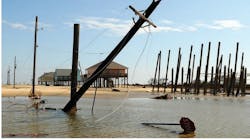This is part two of a six-part Microgrid Knowledge Special Report Series that highlights the rise of the reliability-as-a-service model. This post focuses on power outage costs and the monetary value of electric reliability.
Download the full report.
It is difficult to calculate what a power outage costs an economy or even an individual business. Losses tend to be determined in retrospect, after a storm or other calamity. They represent our best estimates of inputs, such as lost worker productivity, manufacturing disruptions, lost inventory or lost consumer purchases. Most of those losses are not recoverable. And, potentially more damaging, they affect customer confidence, which can result in the erosion of future revenues.
The numbers may not be exact, but they are substantial. A digital economy suffers mightily when it loses its most basic feedstock, electricity.
The 2017 hurricane season was particularly expensive. Estimates put Hurricane Harvey losses alone at $125 billion, making it one of the most costly natural disasters in U.S. history. The storm knocked out 10,000 MW of generating capacity, according to the U.S. Energy Information Administration, and it left hundreds of thousands of customers without electricity along Texas’ Gulf Coast.
One storm can have a tremendous effect.
Who suffers most from outages
Some businesses face steeper losses than others. Eight key U.S. market segments studied by energy consultant E Source forfeit about $27 billion per year due to power outages. On a more granular level, the E Source report found that manufacturers tend to suffer the most from long outages, followed by financial service companies, healthcare, and grocery stores. These industries also face significant losses during short outages and power quality disturbances. Consider a car manufacturer that makes about 1,200 cars a day: The cost for each car is roughly $50,000. That means just one day offline costs the factory $60 million.
Industries dealing with perishable products, from food to pharmaceuticals, are also vulnerable. In one dramatic example, the loss of power in Puerto Rico in the wake of Hurricane Maria resulted in shortages of medical supplies such as IV bags and some drugs. Puerto Rico pharmaceutical manufacturers produce about 10 percent of all drugs consumed by Americans, according to the U.S. Federal Drug Administration.
Food products are perishable at any stage along the supply chain, from manufacture to sale. In Winchester, Virginia, HP Hood installed a 15-MW microgrid at its 150-million gallon milk processing plant as insurance against outages. For Hood, even a brief loss of power could result in the plant shutting down for up to 12 hours to clean and re-sterilize equipment.
The Department of Defense reported 127 outages of eight hours or longer in 2015, at a cost of $179,087 per day.
Loss of power and electricity reliability is more critical at hospitals and military installations, where interruption of electrical service can be life threatening. The Department of Defense reported 127 outages of eight hours or longer in 2015, at a cost of $179,087 per day. The toll can be even higher at medical installations. Healthcare organizations face average costs of $690,000 per outage, according to a Ponemon Institute/Emerson Network Power report. Add in the potential for the loss of life, and that calculation becomes imponderable.
Valuable electric reliability data for risk officers
Retrospective studies aside, risk officers increasingly want to know what an outage might cost their business. The figure is useful in determining if a microgrid is a wise investment.
Traditionally, understanding power outage costs also helps a business determine if it makes sense to shut down when the grid is under strain and energy prices spike. A planned outage is much less costly to a business than an unplanned outage. For example, if the price of electricity spiked to $200/MWh, a manufacturer of cast iron may decide it is not economic to continue to operate, so they shut down until prices stabilize and then resume operations.
“It is an education process for businesses to understand the implication of interrupted operations.” — Thomas McAndrew, founding partner, president and CEO of microgrid developer, ERock.
On the other hand, there are certain processes that are costly to stop and start. The cost could be high for a plastic manufacturer to shut down until the next day and have to clean cold plastic out of molds. Or an oil and gas producer working on tight margins could shut down to avoid electric price spikes but it might take the producer days to get back online. As a result, the producer’s customers might lose business because they can’t fulfill their contracts.
Under normal circumstances, businesses either reluctantly accept the losses from outages, or they may proactively curtail operations to avoid unplanned disruptions. However, reliability-as-a-service providers take on the responsibility of managing economic and system volatility, so that customers reap the benefits and are not burdened with making day-to-day decisions on when to disconnect from the grid or how to recover from an outage.
Determining power outage costs
No single way exists to determine the value of electric reliability. Every business is different and operates under a unique set of circumstances. In some cases, the value of electric reliability could be as simple as the temporary loss of a process. Often, however, the value extends beyond the obvious.
“It is an education process for businesses to understand the implication of interrupted operations,” said Thomas McAndrew, founding partner, president and CEO of microgrid developer at Enchanted Rock. “By jointly analyzing previous events, or reviewing data from similar organizations, we try to put a price on grid interruption or power disturbances, to make the decision much easier.”
What will it cost to avoid the loss?
Once a business determines the cost of losing power, logical questions follow: What will it cost to avoid this loss? Is the investment worth it? What does a microgrid cost? Where do we find the expertise to build and operate a microgrid?
In the next chapter of this series, we explain why a microgrid can be affordable when it is offered through a reliability-as-a-service model.
This six-part Microgrid Knowledge Special Report Series will also cover the following topics over the coming weeks:
- Microgrid Installation Before Calamity: Resiliency Planning
- Reliability-as-a-Service: What is an Affordable Microgrid?
- Why a Natural Gas-Fired Microgrid?
- Leveraging Wholesale Markets to Create the Affordable Microgrid
- How Microgrids Served Texas During Hurricane Harvey
We welcome you to download this special report, “The Affordable Microgrid: Securing Electric Reliability through Outsourcing,” free of charge, courtesy of Enchanted Rock, and to widely distribute the link.







